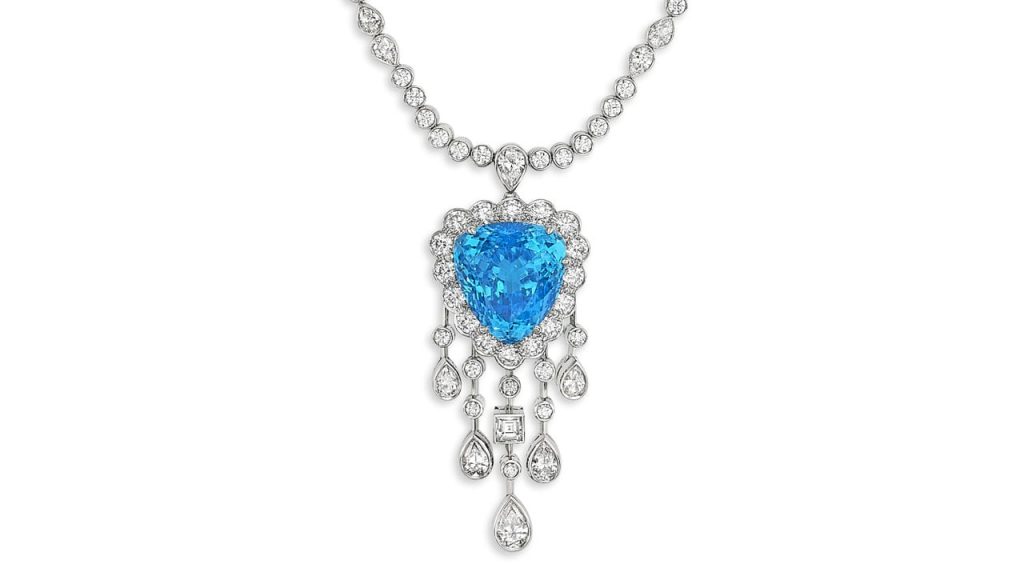
Live jewelry auctions are returning with the first one being held in Geneva by Sotheby’s on June 23 offering a diverse collection of statement diamonds, colored gems and historic jewels.
Sotheby’s Part II Magnificent Jewels & Nobel Jewels – Geneva sale was originally scheduled for May but was postponed due to the novel coronavirus pandemic. The effects of the worldwide spread of this infectious disease is still being felt as dramatically reduced travel and freight shipments have hampered the efforts of jewelry specialists to assess gems and jewels. Most likely because of this and the scheduling changes the sale consists of only 48 lots, far fewer than usual for a live international auction. However, there will be a strong and varied selection gems and jewels.
The live sale is accompanied by an online auction, Sotheby’s Part I Magnificent Jewels & Nobel Jewels – Geneva, with 178 lots dating from the 19th century through to the present day. It includes jewels from renowned jewelry houses, including Sterlé, Suzanne Belperron, René Boivin and Hemmerle. This sale has begun and will run till June 24.
Not surprisingly colored diamonds are among the top lots in live sale, with blues, pinks and yellows dominating. The auction is led by a 3.01-carat fancy vivid blue step-cut, diamond. The colored gem set on a ring has a clarity grade of VS1 (very small inclusions), according to the Gemological Institute of America report. Its estimate is $4.3 – $6.3 million.Most Popular In: Watches & Jewelry

It’s followed by a 7-carat marquise-shaped fancy intense pink diamond. It received a clarity grade of VVS2 (very, very small inclusions) by the GIA. It is set on a ring flanked by fancy-shaped diamonds and with a shank lined with brilliant-cut diamonds. It’s the first time this diamond has come to auction in more than 30 years, where it has been kept in the same private collection. Its estimate is $2.5 – $3.5 million.
There’s also a selection of large, colorless diamonds led by a 21.56-carat D color, VVS1 clarity diamond by Lorraine Schwartz, an American bespoke high jewelry designer with a large celebrity clientele. The gem has excellent polish and symmetry, according to the GIA report.

Among the noble jewels in the sale, the standout is an emerald and diamond necklace owned by Consuelo Montagu (1853-1909), Duchess of Manchester, which was given to her as a wedding gift. Born in New York to parents of Cuban descent, she was known for her match-making skills, inspiring her wealthy friends to find suitable husbands in the United Kingdom, according to the auction house. Her ability to bring together American fortunes with noble titles led to the coining of the phrase “Million Dollar Princesses.” This antique jewel was displayed at the Victoria & Albert Museum in London for 22 years. Its estimate is $300,000 – $400,000.

In addition, there’s a collection of jewels owned by Baroness Bachofen von Echt (1877 – 1959), a New York native who became German nobility through marriage. Pieces from her collection includes a diamond bracelet (estimate $100,000 – $150,000) and diamond clips (estimate $60,000 – $100,000), both made by Cartier, along with creations by Verdura and Hemmerle.
Two impressive sapphires are included in the sale. The first is a 105.58-carat Ceylon sapphire set on a gold ring. The gem is accompanied by reports from the Swiss Gemmological Institute (SSEF) and from Gübelin that both state that there are no indications of heating, with “a few minor nicks and chips consistent with normal wear.” Its estimate is $500,000 – $700,000.

The second is a 16.11-carat Kashmir sapphire set on an 18k gold and diamond ring. The gem is accompanied by two reports from the Swiss Gemmological Institute and from Gübelin that both state that there are no indications of heating and in “very good condition.” Its estimate is $300,000 – $500,000
The continued importance of signed jewels is evident in this sale with pieces from historic and contemporary jewelry houses, including Bulgari, Cartier, Fred, Furst. Harry Winston, Hemmerle, René Bovin, Tiffany & Co. and Van Cleef & Arpels.

One of the standouts in this group is a Cartier diamond and platinum bracelet, Course de Feuillage, 1926. The entire bracelet is set with circular-, single-cut and baguette diamonds that combines geometric shapes with the stylized representation of leaves. Its estimate is $200,000 – $300,000.
Source: DCLA




